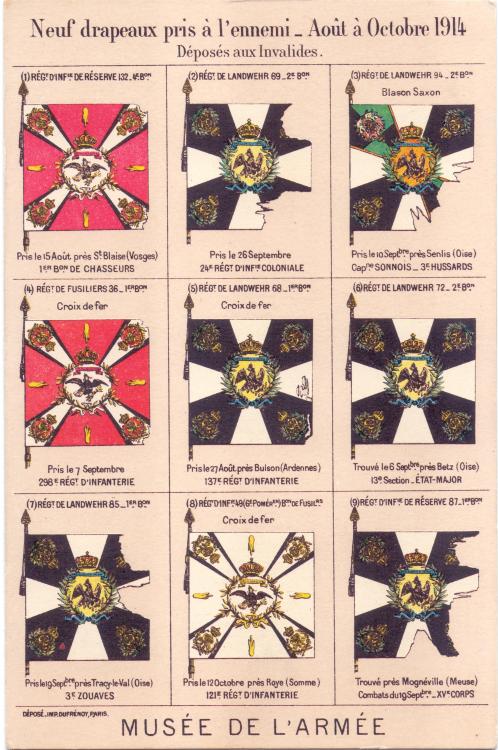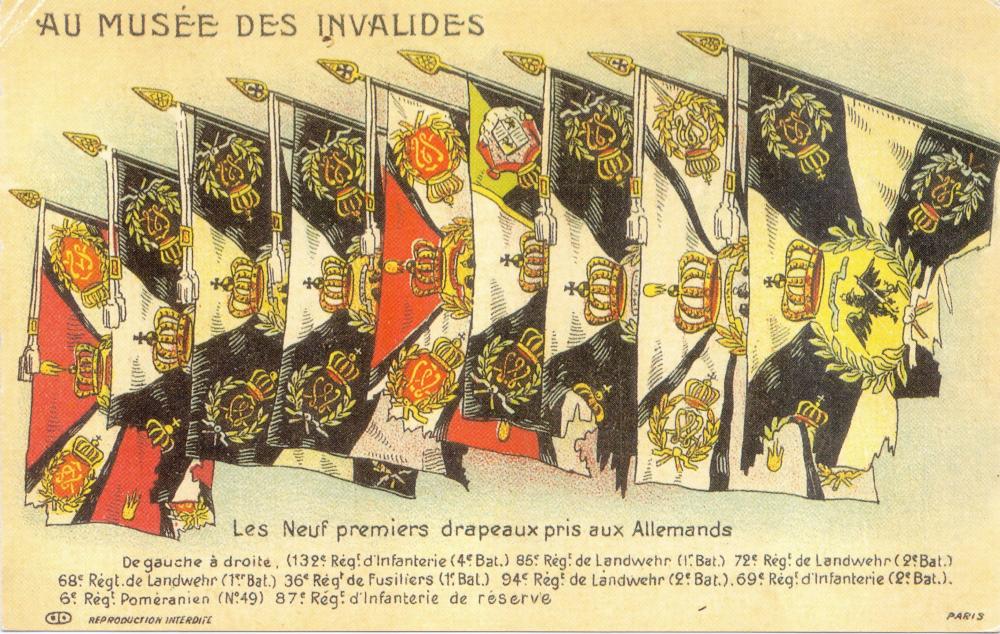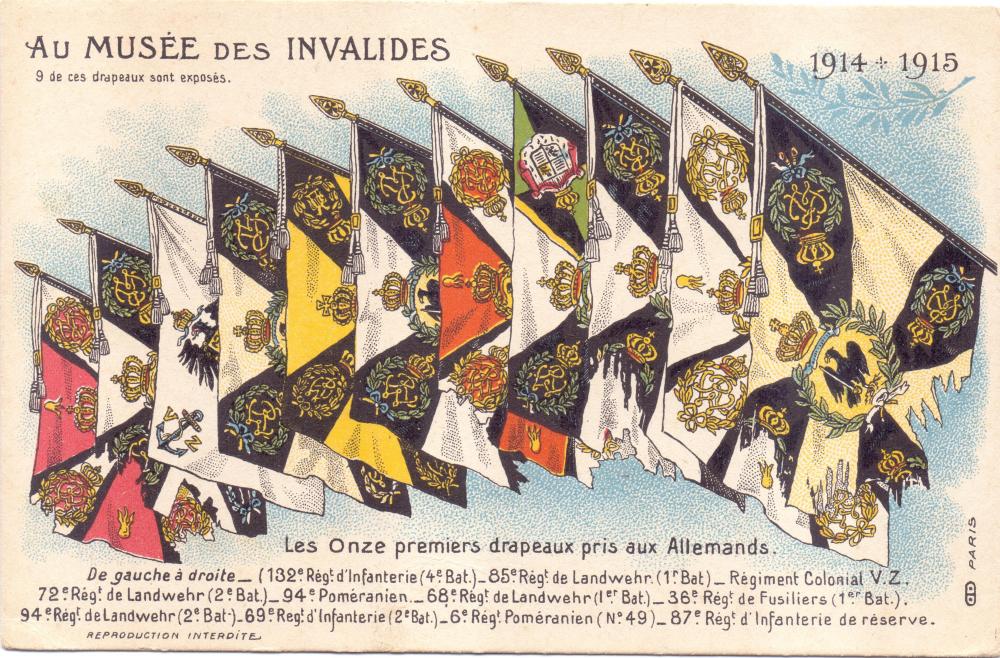-
Posts
3,101 -
Joined
-
Last visited
-
Days Won
6
Content Type
Profiles
Forums
Blogs
Gallery
Events
Store
Everything posted by The Prussian
-
Hello! I received this nice detailed photo, but I only know, that one of the arm patches is from the MG-Troops. I wonder about the basence of the collar-numbers, which were worn in that era. The single circle is unknown to me. Has anyone infos about that troop and date, please? Thanks a lot in advance
-
Hello Daniel! The unit in the stamp is: Reserve-Landwehr-Bataillon (Altona) N°86. Underneath the signature I read: "Prem.Lt. in Inf.Rgt.31" (1st lieutenant in Inf.Rgt.31) The Inf.Rgt.31 also was in Altona. It doesn´t exist a ranklist 1876, only a combined one for 1876/77. There I found in Inf.Rgt.31 a Prem.Lt. BRAMEREL I think that fits.
-
Hello! Unfortunateley nothing to help... I read: His dear Leo in remembrance in finding each other again in Münsterlager near Reims. March 15, 1918 Crécy sue Serre Crécy > Reims = ~65km Probably he found his friend Leo in Münsterlager and wrote the card in Crécy. Münterlager will be a training ground. The card was written one week before the "Great battle of France" (March, 21.) Crécy is near Laon. That belonged to the 7th army. But I don´t know what the "J" could be
-
Hi Daniel! I´m not sure, I don´t have the1881 ranklist. Staff of 2. Hanseatisches Landwehr_Regiment Nr.76 (1st bataillon Hamburg): 1879: Bez.Kdr.: Oberstleutnant z.D. v. Restorff ; Adj.: Pr.Lt. Gestefeld ; 2nd Staff officer: Major z.D. v. Borcke 1883: Bez.Kdr.: Oberstleutnant z.D. v. Restorff ; Adj.: Sec-Lt. v. Hehnitz ; 2nd staff officer: Major z.D. Frhr. v. Ledebur ; 3rd staff officer: Major z.D. Frhr. Treusch v. Buttlar-Brandenfels Does someone fit?
-
Hello! There is a "sticky picture album" from "Bulgaria Fahnenbilder", called "Ruhmreiche Fahnen deutscher Geschichte" (published in the 30s) You can get it at ebay, if you look at "Ruhmreiche Fahnen deutscher Geschichte" But be careful, that the sticky pictures are complete 256 pictures)! Those albums can be found between 20 an 80€. Each troop flag is described. But it´s from the 30s, so you can´t see where the flags are today! German language! https://www.ebay.de/sch/i.html?_from=R40&_trksid=p4712.m570.l1313.TR1.TRC0.A0.H0.XRuhmreiche+Fahnen+deutscher+Geschichte.TRS0&_nkw=Ruhmreiche+Fahnen+deutscher+Geschichte&_sacat=0
-
Hello! Here are a few infos: https://www.ehrenzeichen-orden.de/deutsche-staaten/gemeinsame-kriegsdenkmunze-fur-die-hanseatische-legion-1815.html Translated with www.DeepL.com/Translator: Common War Memorial Coin for the Hanseatic Legion 1815 This war memorial coin was donated together by the 3 Hanseatic cities with council resolution in each of the 3 cities. (9 March 1815 Hamburg, 31 March 1815 Bremen, 7 June 1815 Lübeck) The medal was intended for all soldiers who fought during the campaign of 1813, 1814 in the Hanseatic Legion or stood in the field in the citizen guard. The Hanseatic Legion was a unit made up of volunteers recruited to support the cavalry under Colonel Tettendorf in the 3 Hanseatic cities. The troop strength was approximately 3,800 men, including officers, doctors and civil servants. The stamps of the medal were made by G. Loos in Berlin. About 4400 medals were made in silver and 12 in gold. The gold medals were awarded to statesmen at the Congress of Vienna. Later, another 18 gold medals without eyelets were delivered to Lübeck. 6 were awarded by the city of Lübeck as a gift of honour. 5 medals were ordered privately. The medal had to be applied for. A proof of belonging to the contingent had to be presented and in the case of soldiers who had already been dismissed, the honourable farewell. Until the award ceremony, the persons received a patent entitling them to receive it. Round silver medal with edge. At the top a large eyelet. Front side: Based on an oak tree 3 oval signs with the city coats of arms of the 3 cities. On the left Bremen, in the middle Lübeck and on the right Hamburg. Above it you can see foliage. Above at the edge the bent old writing: - God - was - with - us - small below the pedestal - LOOS - Back side: At the edge a wide ring on top with the writing: - Hanseatic - Legion - Below the city names: - Lübeck. - Bremen. - Hamburg. – In the enclosed field the 5-line German font: - The -/- patriotic -/- fight -/- 1813. - 1814. -/- in - memory -. Below a cross in Johanniter/Maltese form. Band: red/white 35 mm wide.
-
Hello! Can you recognize the buttons? Lion or crown? Are you sure he is bavarian? The bavrian bravery medal could be received by bavarians. So he would have worn that medal above the Iron Cross. If it is the bavarian bravery medal, shouldn´t he have another bavarian medal? I assume it´s a medal from another german state, which was worn with the Iron Cross. Maybe the military merit medal from Lippe-Detmold? Here we´ve got an Unteroffizier of Foot-artillery-bataillon 124 Please have a look:
-
Hello! His units were: 12.10.04-18.9.06: Fusilier-Regiment 38, 10th comp. 14.8.-18.9.08: Manoeuvre in Inf.Rgt.154, 5th. comp. 11.-24.5.11: Manoeuvre in Inf.Rgt.154, 4th comp. 14.8.14-10.7.17: Eisenbahn-Hilfs-Bataillon 1, 4th comp. (Railroad-support-bataillon) 11.7.17: Ersatz-Bataillon, Eisenbahn-Rgt.4 13.7.17: I.Ersatz-Bataillon, Eisenbahn-Rgt. 4, 3rd comp. 27.10.17: II.Ersatz-Bataillon, Eisenbahn-Rgt.4, 3rd comp. 10.12.17: Eisenbahn-Betriebs-Kompagnie 83 26.12.17: in Eisenbahn-Betriebs-Kompagnie 83 eingetroffen (arrived) He received Iron Cross 2nd class April 20, 1917 and the turkish Iftikar medal February 23, 1917. The Iftihar Medal was originally written: İftihar Nişanı (Order of Glory). But I think, that is wrong, because as far as I know that medal was only awarded to higher turkish officers. I can´t believe, a simple soldier from a Railroiad-Support-Bataillon did receive such an ordre! In WW1 the following awards were available for military persons: Order of the Mejedie (Order of Osmanieh) Imtiaz Medal Liakat Medal Iron Crescent Could you please show the left side of page 12 (under the stamp)
-
Hello! 1) Dr. Nikolaus Anton Foohs, priest of 3rd bavarian Inf.Div. Wounded badge for two wounds, EK I and EK II, MVO4 with crown and swords, Prinz-Luitpold-Medal 2) Rupert Mayer, priest of 8th bav. Res.Div. ("man in the mirror") EK I (first german priest with EK I) and II, MVO4, Würtemberg order of merit, austrian Franz-Joseph medal



.jpg.80158c2a2f9029740ef4e63f4359c278.jpg)
.jpg.76ca384f93f1fa38f0ef32789e0c3f45.jpg)
.jpg.615bf0a3701e33b6710ab01a561313de.jpg)
.thumb.jpg.a7ec3b1cd1dd374a527aea48893d0ad1.jpg)
.jpg.0df27c45d60b5cc048f0b62d7f7787b4.jpg)
.jpg.e3023635cf74ce08bb684a98760cd7cc.jpg)
.jpg.4953c4ae6b67760099d68a47b1da7ea5.jpg)
.jpg.c2a446bbce785cc200c1f9b356f9330e.jpg)

.thumb.jpg.1aba68965e990a2a61a11ddad4396ca9.jpg)



.thumb.jpg.f978335f0e0ff2c9efb39619396ab14d.jpg)

-Kopie.thumb.jpg.15dd59037f76f75ecb015aa0d039a764.jpg)